ACCT6004 Group Case Study: Wilkerson Company Profitability Analysis
VerifiedAdded on 2022/10/14
|20
|3753
|480
Case Study
AI Summary
This case study report analyzes the Wilkerson Company's financial performance, addressing issues in management accounting, cost behaviors, and estimation techniques. It explores ethical and organizational challenges, categorizes costs, and examines the relevance of quantitative and qualitative costing methods in decision-making. The report focuses on the company's competitive situations, particularly regarding overhead assignment and the implementation of an Activity-Based Costing (ABC) model. It provides detailed calculations and comparisons of product costs and profitability under both traditional and ABC costing systems. The analysis includes recommendations for improving the company's profitability and reducing production costs, along with a discussion of concerns about the ABC system and changes in incentive structures. The study aims to provide insights into strategic decision-making and cost management within the context of the Wilkerson Company's operations.
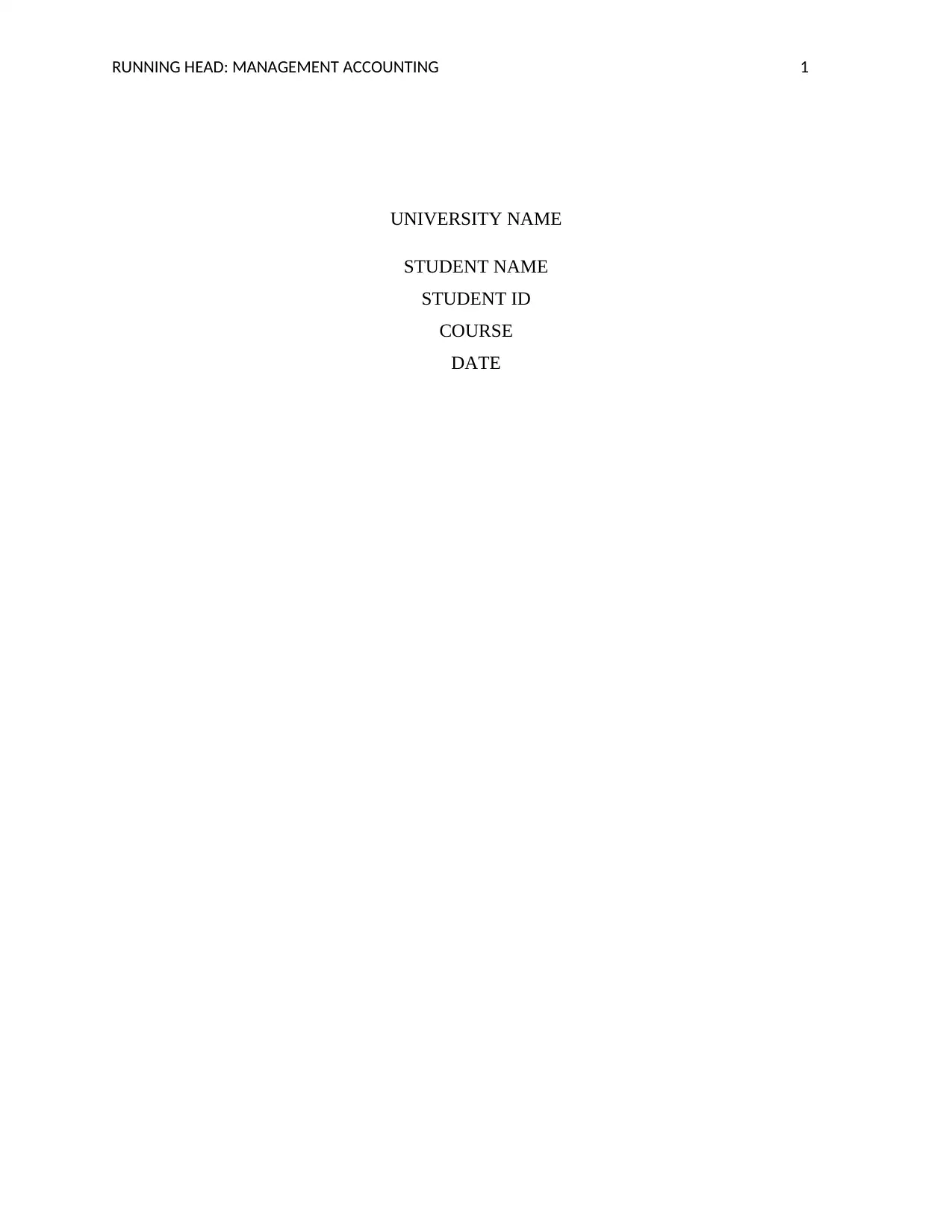
RUNNING HEAD: MANAGEMENT ACCOUNTING 1
UNIVERSITY NAME
STUDENT NAME
STUDENT ID
COURSE
DATE
UNIVERSITY NAME
STUDENT NAME
STUDENT ID
COURSE
DATE
Paraphrase This Document
Need a fresh take? Get an instant paraphrase of this document with our AI Paraphraser
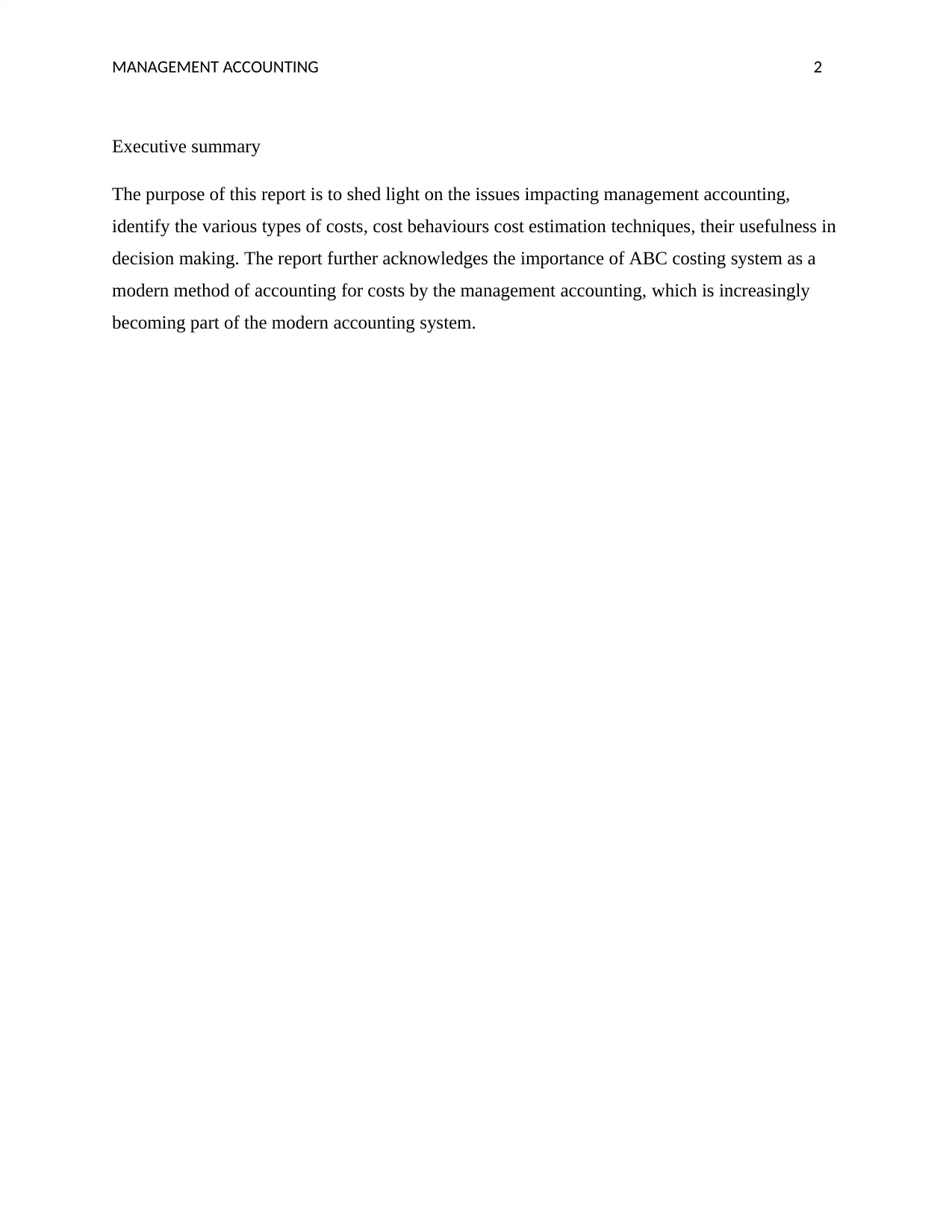
MANAGEMENT ACCOUNTING 2
Executive summary
The purpose of this report is to shed light on the issues impacting management accounting,
identify the various types of costs, cost behaviours cost estimation techniques, their usefulness in
decision making. The report further acknowledges the importance of ABC costing system as a
modern method of accounting for costs by the management accounting, which is increasingly
becoming part of the modern accounting system.
Executive summary
The purpose of this report is to shed light on the issues impacting management accounting,
identify the various types of costs, cost behaviours cost estimation techniques, their usefulness in
decision making. The report further acknowledges the importance of ABC costing system as a
modern method of accounting for costs by the management accounting, which is increasingly
becoming part of the modern accounting system.
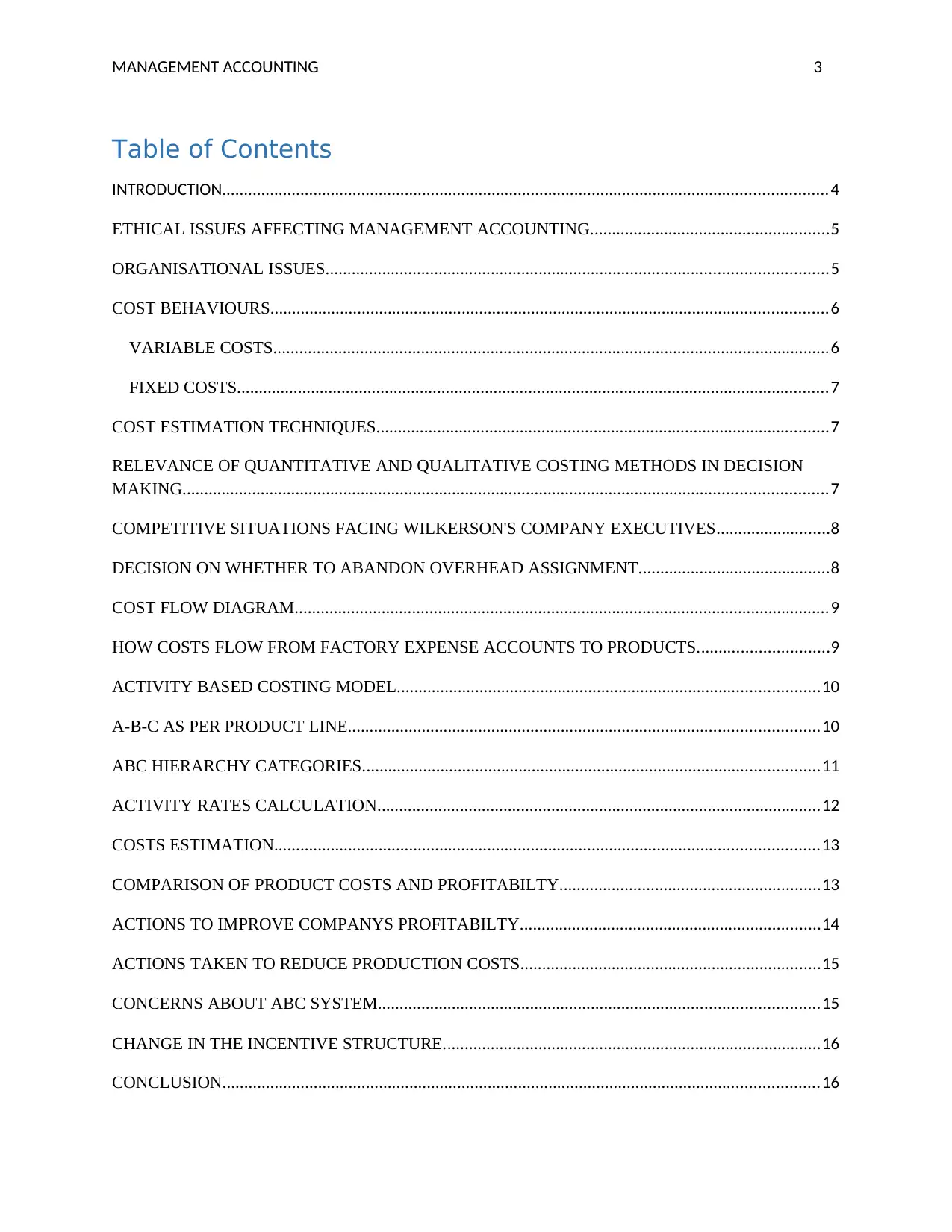
MANAGEMENT ACCOUNTING 3
Table of Contents
INTRODUCTION...........................................................................................................................................4
ETHICAL ISSUES AFFECTING MANAGEMENT ACCOUNTING.......................................................5
ORGANISATIONAL ISSUES...................................................................................................................5
COST BEHAVIOURS................................................................................................................................6
VARIABLE COSTS................................................................................................................................6
FIXED COSTS........................................................................................................................................7
COST ESTIMATION TECHNIQUES........................................................................................................7
RELEVANCE OF QUANTITATIVE AND QUALITATIVE COSTING METHODS IN DECISION
MAKING....................................................................................................................................................7
COMPETITIVE SITUATIONS FACING WILKERSON'S COMPANY EXECUTIVES..........................8
DECISION ON WHETHER TO ABANDON OVERHEAD ASSIGNMENT............................................8
COST FLOW DIAGRAM...........................................................................................................................9
HOW COSTS FLOW FROM FACTORY EXPENSE ACCOUNTS TO PRODUCTS..............................9
ACTIVITY BASED COSTING MODEL.................................................................................................10
A-B-C AS PER PRODUCT LINE............................................................................................................10
ABC HIERARCHY CATEGORIES.........................................................................................................11
ACTIVITY RATES CALCULATION......................................................................................................12
COSTS ESTIMATION.............................................................................................................................13
COMPARISON OF PRODUCT COSTS AND PROFITABILTY............................................................13
ACTIONS TO IMPROVE COMPANYS PROFITABILTY.....................................................................14
ACTIONS TAKEN TO REDUCE PRODUCTION COSTS.....................................................................15
CONCERNS ABOUT ABC SYSTEM.....................................................................................................15
CHANGE IN THE INCENTIVE STRUCTURE.......................................................................................16
CONCLUSION.........................................................................................................................................16
Table of Contents
INTRODUCTION...........................................................................................................................................4
ETHICAL ISSUES AFFECTING MANAGEMENT ACCOUNTING.......................................................5
ORGANISATIONAL ISSUES...................................................................................................................5
COST BEHAVIOURS................................................................................................................................6
VARIABLE COSTS................................................................................................................................6
FIXED COSTS........................................................................................................................................7
COST ESTIMATION TECHNIQUES........................................................................................................7
RELEVANCE OF QUANTITATIVE AND QUALITATIVE COSTING METHODS IN DECISION
MAKING....................................................................................................................................................7
COMPETITIVE SITUATIONS FACING WILKERSON'S COMPANY EXECUTIVES..........................8
DECISION ON WHETHER TO ABANDON OVERHEAD ASSIGNMENT............................................8
COST FLOW DIAGRAM...........................................................................................................................9
HOW COSTS FLOW FROM FACTORY EXPENSE ACCOUNTS TO PRODUCTS..............................9
ACTIVITY BASED COSTING MODEL.................................................................................................10
A-B-C AS PER PRODUCT LINE............................................................................................................10
ABC HIERARCHY CATEGORIES.........................................................................................................11
ACTIVITY RATES CALCULATION......................................................................................................12
COSTS ESTIMATION.............................................................................................................................13
COMPARISON OF PRODUCT COSTS AND PROFITABILTY............................................................13
ACTIONS TO IMPROVE COMPANYS PROFITABILTY.....................................................................14
ACTIONS TAKEN TO REDUCE PRODUCTION COSTS.....................................................................15
CONCERNS ABOUT ABC SYSTEM.....................................................................................................15
CHANGE IN THE INCENTIVE STRUCTURE.......................................................................................16
CONCLUSION.........................................................................................................................................16
⊘ This is a preview!⊘
Do you want full access?
Subscribe today to unlock all pages.

Trusted by 1+ million students worldwide
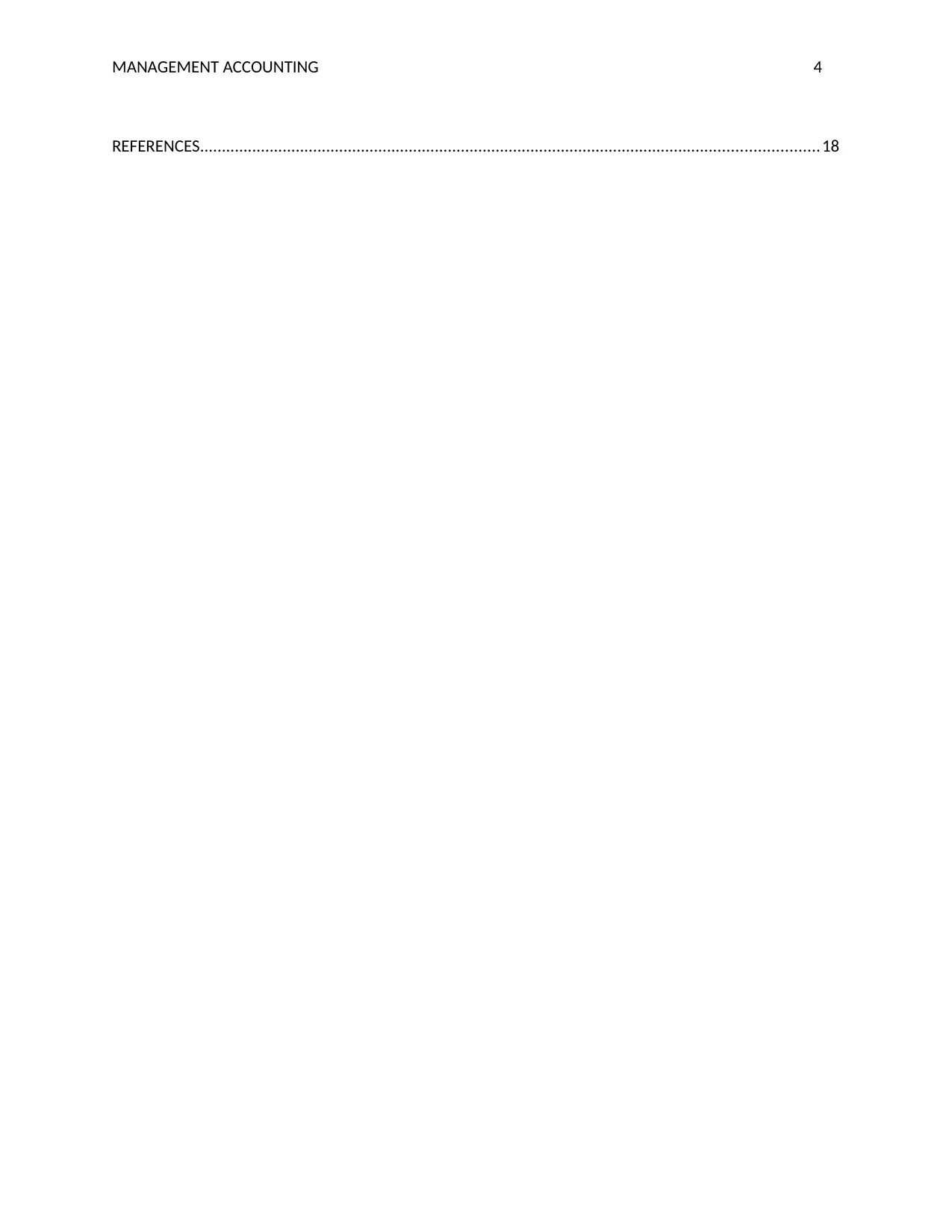
MANAGEMENT ACCOUNTING 4
REFERENCES..............................................................................................................................................18
REFERENCES..............................................................................................................................................18
Paraphrase This Document
Need a fresh take? Get an instant paraphrase of this document with our AI Paraphraser
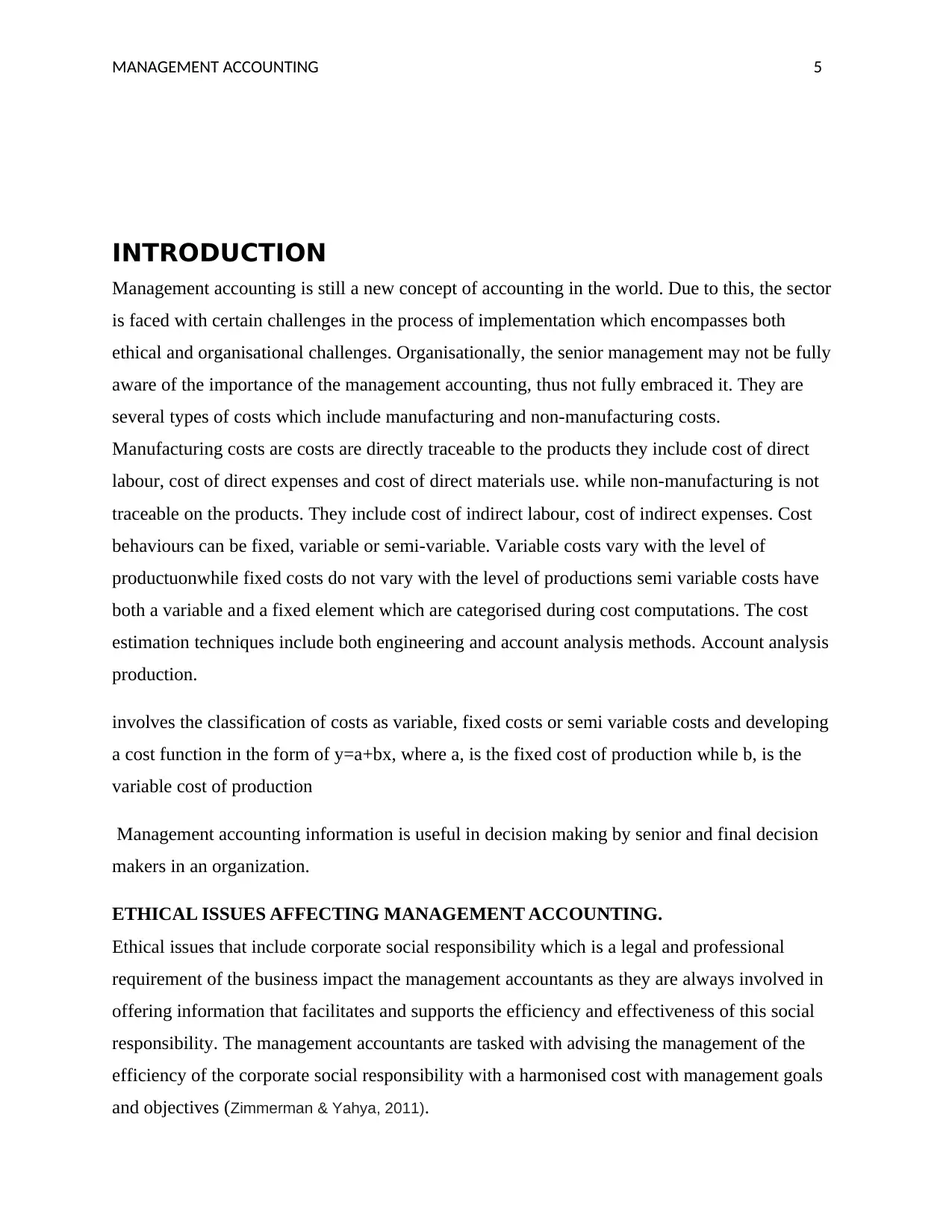
MANAGEMENT ACCOUNTING 5
INTRODUCTION
Management accounting is still a new concept of accounting in the world. Due to this, the sector
is faced with certain challenges in the process of implementation which encompasses both
ethical and organisational challenges. Organisationally, the senior management may not be fully
aware of the importance of the management accounting, thus not fully embraced it. They are
several types of costs which include manufacturing and non-manufacturing costs.
Manufacturing costs are costs are directly traceable to the products they include cost of direct
labour, cost of direct expenses and cost of direct materials use. while non-manufacturing is not
traceable on the products. They include cost of indirect labour, cost of indirect expenses. Cost
behaviours can be fixed, variable or semi-variable. Variable costs vary with the level of
productuonwhile fixed costs do not vary with the level of productions semi variable costs have
both a variable and a fixed element which are categorised during cost computations. The cost
estimation techniques include both engineering and account analysis methods. Account analysis
production.
involves the classification of costs as variable, fixed costs or semi variable costs and developing
a cost function in the form of y=a+bx, where a, is the fixed cost of production while b, is the
variable cost of production
Management accounting information is useful in decision making by senior and final decision
makers in an organization.
ETHICAL ISSUES AFFECTING MANAGEMENT ACCOUNTING.
Ethical issues that include corporate social responsibility which is a legal and professional
requirement of the business impact the management accountants as they are always involved in
offering information that facilitates and supports the efficiency and effectiveness of this social
responsibility. The management accountants are tasked with advising the management of the
efficiency of the corporate social responsibility with a harmonised cost with management goals
and objectives (Zimmerman & Yahya, 2011).
INTRODUCTION
Management accounting is still a new concept of accounting in the world. Due to this, the sector
is faced with certain challenges in the process of implementation which encompasses both
ethical and organisational challenges. Organisationally, the senior management may not be fully
aware of the importance of the management accounting, thus not fully embraced it. They are
several types of costs which include manufacturing and non-manufacturing costs.
Manufacturing costs are costs are directly traceable to the products they include cost of direct
labour, cost of direct expenses and cost of direct materials use. while non-manufacturing is not
traceable on the products. They include cost of indirect labour, cost of indirect expenses. Cost
behaviours can be fixed, variable or semi-variable. Variable costs vary with the level of
productuonwhile fixed costs do not vary with the level of productions semi variable costs have
both a variable and a fixed element which are categorised during cost computations. The cost
estimation techniques include both engineering and account analysis methods. Account analysis
production.
involves the classification of costs as variable, fixed costs or semi variable costs and developing
a cost function in the form of y=a+bx, where a, is the fixed cost of production while b, is the
variable cost of production
Management accounting information is useful in decision making by senior and final decision
makers in an organization.
ETHICAL ISSUES AFFECTING MANAGEMENT ACCOUNTING.
Ethical issues that include corporate social responsibility which is a legal and professional
requirement of the business impact the management accountants as they are always involved in
offering information that facilitates and supports the efficiency and effectiveness of this social
responsibility. The management accountants are tasked with advising the management of the
efficiency of the corporate social responsibility with a harmonised cost with management goals
and objectives (Zimmerman & Yahya, 2011).
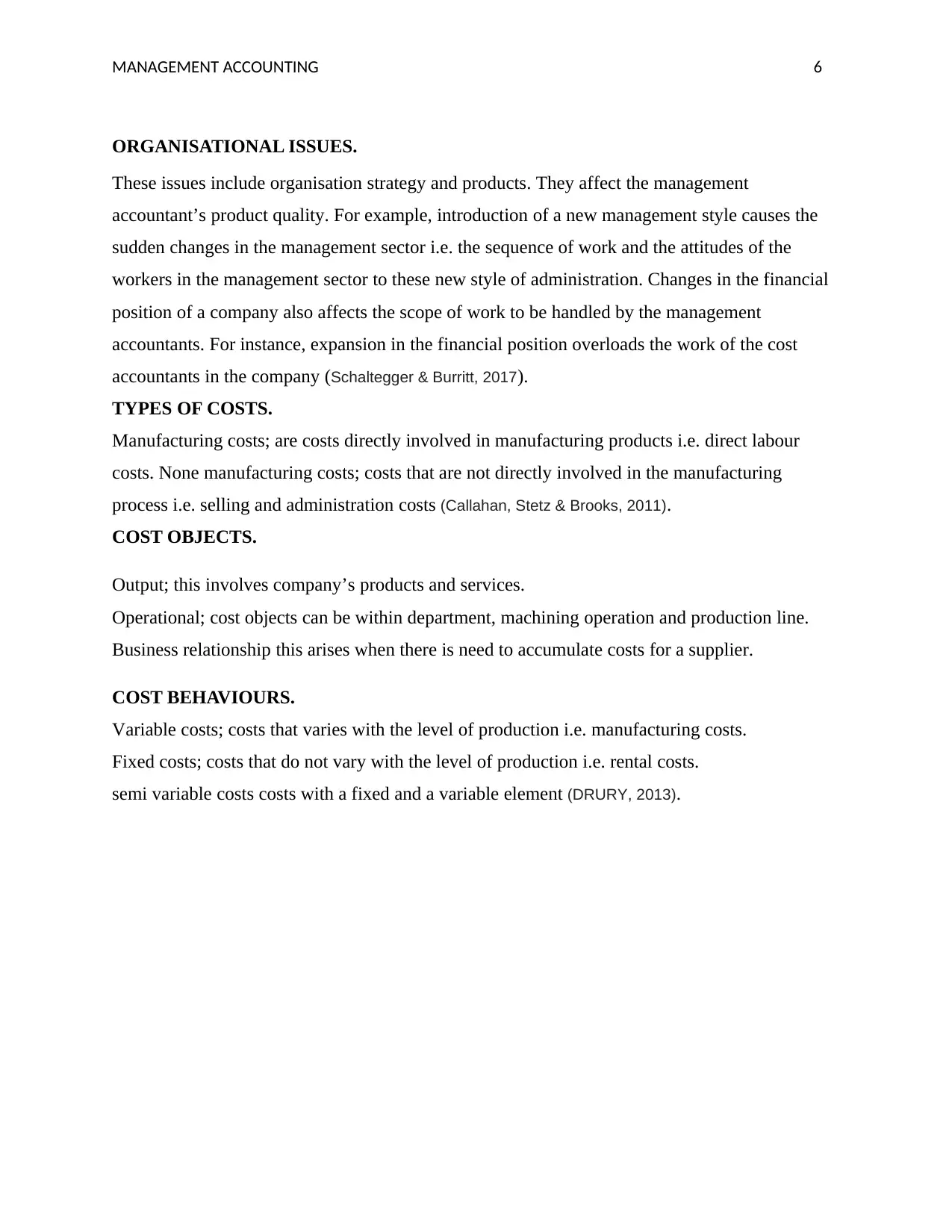
MANAGEMENT ACCOUNTING 6
ORGANISATIONAL ISSUES.
These issues include organisation strategy and products. They affect the management
accountant’s product quality. For example, introduction of a new management style causes the
sudden changes in the management sector i.e. the sequence of work and the attitudes of the
workers in the management sector to these new style of administration. Changes in the financial
position of a company also affects the scope of work to be handled by the management
accountants. For instance, expansion in the financial position overloads the work of the cost
accountants in the company (Schaltegger & Burritt, 2017).
TYPES OF COSTS.
Manufacturing costs; are costs directly involved in manufacturing products i.e. direct labour
costs. None manufacturing costs; costs that are not directly involved in the manufacturing
process i.e. selling and administration costs (Callahan, Stetz & Brooks, 2011).
COST OBJECTS.
Output; this involves company’s products and services.
Operational; cost objects can be within department, machining operation and production line.
Business relationship this arises when there is need to accumulate costs for a supplier.
COST BEHAVIOURS.
Variable costs; costs that varies with the level of production i.e. manufacturing costs.
Fixed costs; costs that do not vary with the level of production i.e. rental costs.
semi variable costs costs with a fixed and a variable element (DRURY, 2013).
ORGANISATIONAL ISSUES.
These issues include organisation strategy and products. They affect the management
accountant’s product quality. For example, introduction of a new management style causes the
sudden changes in the management sector i.e. the sequence of work and the attitudes of the
workers in the management sector to these new style of administration. Changes in the financial
position of a company also affects the scope of work to be handled by the management
accountants. For instance, expansion in the financial position overloads the work of the cost
accountants in the company (Schaltegger & Burritt, 2017).
TYPES OF COSTS.
Manufacturing costs; are costs directly involved in manufacturing products i.e. direct labour
costs. None manufacturing costs; costs that are not directly involved in the manufacturing
process i.e. selling and administration costs (Callahan, Stetz & Brooks, 2011).
COST OBJECTS.
Output; this involves company’s products and services.
Operational; cost objects can be within department, machining operation and production line.
Business relationship this arises when there is need to accumulate costs for a supplier.
COST BEHAVIOURS.
Variable costs; costs that varies with the level of production i.e. manufacturing costs.
Fixed costs; costs that do not vary with the level of production i.e. rental costs.
semi variable costs costs with a fixed and a variable element (DRURY, 2013).
⊘ This is a preview!⊘
Do you want full access?
Subscribe today to unlock all pages.

Trusted by 1+ million students worldwide
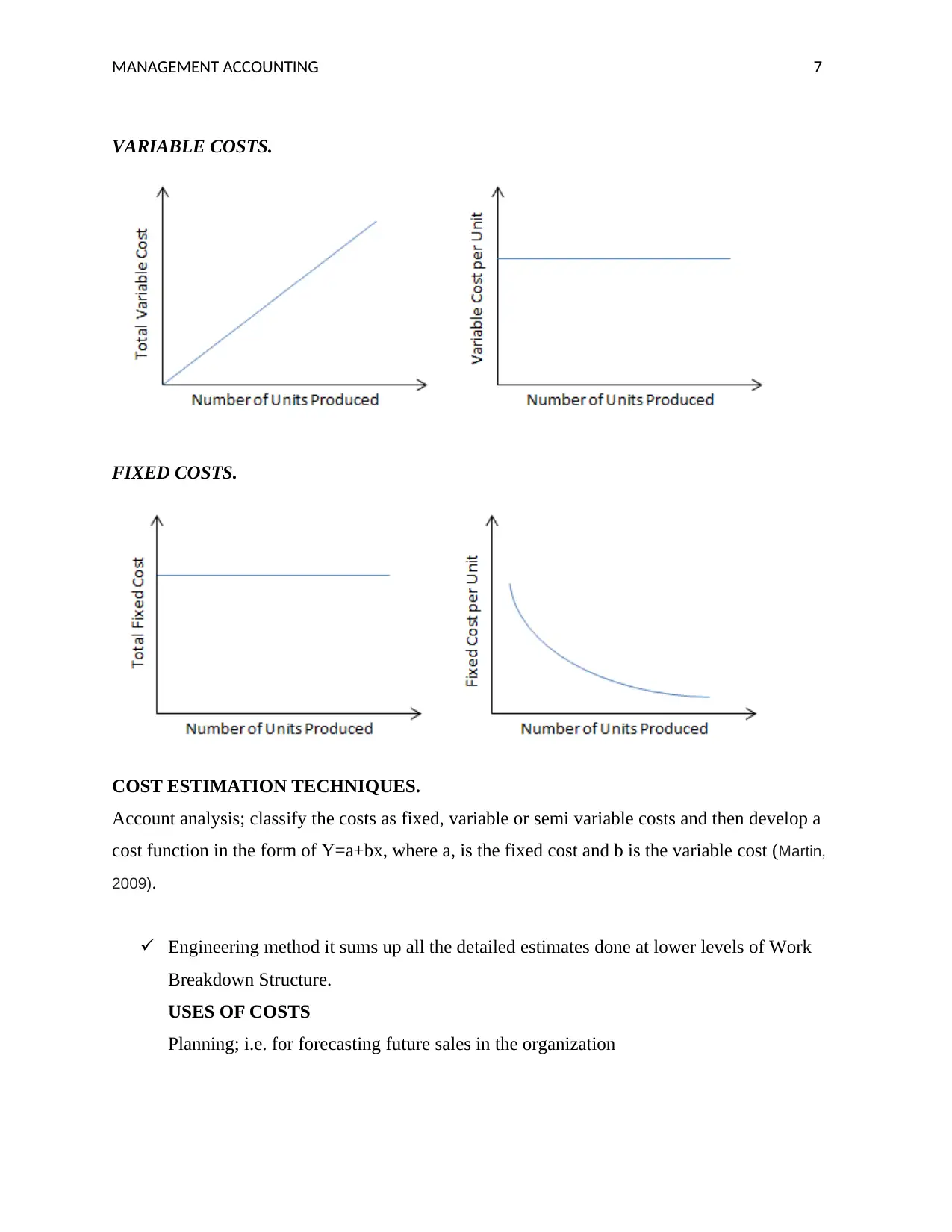
MANAGEMENT ACCOUNTING 7
VARIABLE COSTS.
FIXED COSTS.
COST ESTIMATION TECHNIQUES.
Account analysis; classify the costs as fixed, variable or semi variable costs and then develop a
cost function in the form of Y=a+bx, where a, is the fixed cost and b is the variable cost (Martin,
2009).
Engineering method it sums up all the detailed estimates done at lower levels of Work
Breakdown Structure.
USES OF COSTS
Planning; i.e. for forecasting future sales in the organization
VARIABLE COSTS.
FIXED COSTS.
COST ESTIMATION TECHNIQUES.
Account analysis; classify the costs as fixed, variable or semi variable costs and then develop a
cost function in the form of Y=a+bx, where a, is the fixed cost and b is the variable cost (Martin,
2009).
Engineering method it sums up all the detailed estimates done at lower levels of Work
Breakdown Structure.
USES OF COSTS
Planning; i.e. for forecasting future sales in the organization
Paraphrase This Document
Need a fresh take? Get an instant paraphrase of this document with our AI Paraphraser
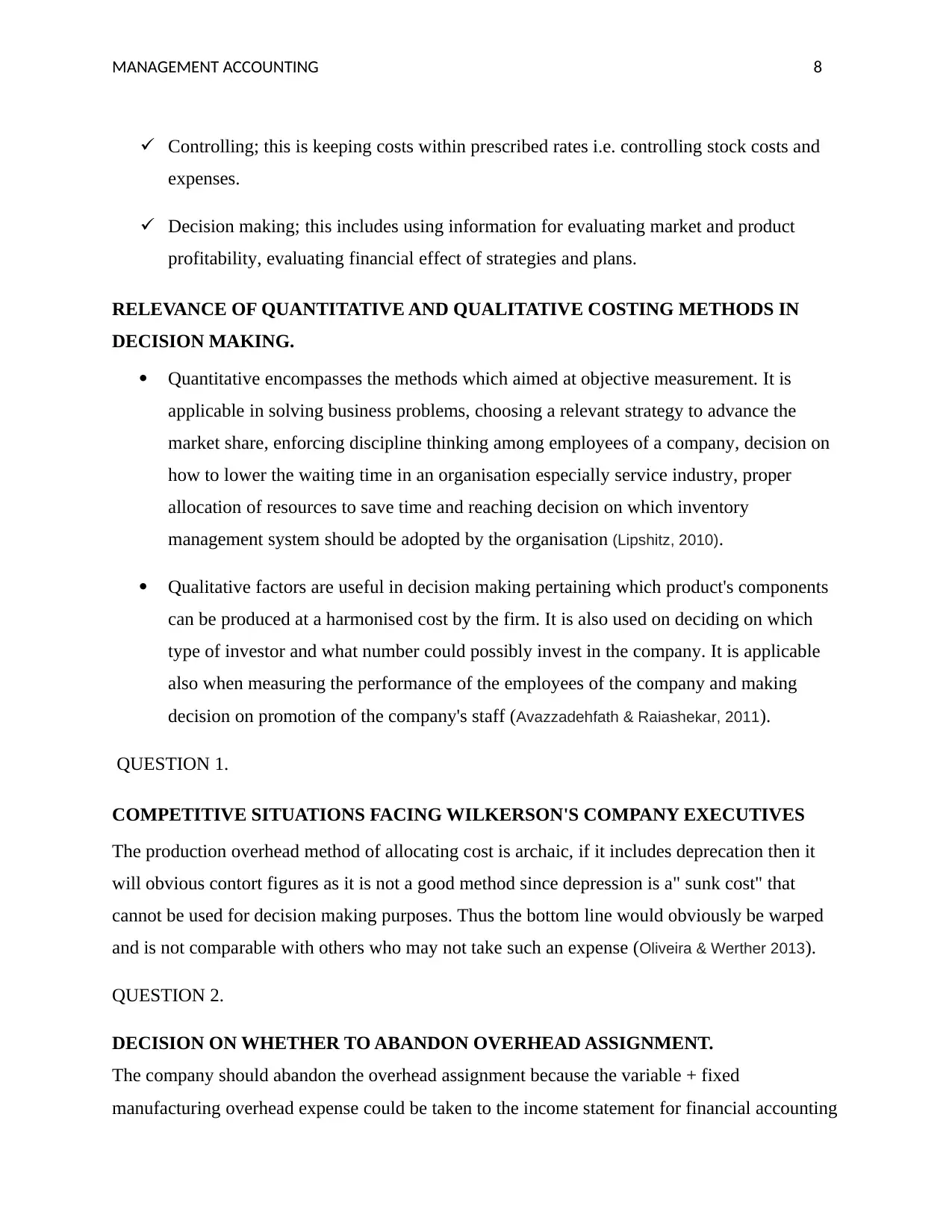
MANAGEMENT ACCOUNTING 8
Controlling; this is keeping costs within prescribed rates i.e. controlling stock costs and
expenses.
Decision making; this includes using information for evaluating market and product
profitability, evaluating financial effect of strategies and plans.
RELEVANCE OF QUANTITATIVE AND QUALITATIVE COSTING METHODS IN
DECISION MAKING.
Quantitative encompasses the methods which aimed at objective measurement. It is
applicable in solving business problems, choosing a relevant strategy to advance the
market share, enforcing discipline thinking among employees of a company, decision on
how to lower the waiting time in an organisation especially service industry, proper
allocation of resources to save time and reaching decision on which inventory
management system should be adopted by the organisation (Lipshitz, 2010).
Qualitative factors are useful in decision making pertaining which product's components
can be produced at a harmonised cost by the firm. It is also used on deciding on which
type of investor and what number could possibly invest in the company. It is applicable
also when measuring the performance of the employees of the company and making
decision on promotion of the company's staff (Avazzadehfath & Raiashekar, 2011).
QUESTION 1.
COMPETITIVE SITUATIONS FACING WILKERSON'S COMPANY EXECUTIVES
The production overhead method of allocating cost is archaic, if it includes deprecation then it
will obvious contort figures as it is not a good method since depression is a" sunk cost" that
cannot be used for decision making purposes. Thus the bottom line would obviously be warped
and is not comparable with others who may not take such an expense (Oliveira & Werther 2013).
QUESTION 2.
DECISION ON WHETHER TO ABANDON OVERHEAD ASSIGNMENT.
The company should abandon the overhead assignment because the variable + fixed
manufacturing overhead expense could be taken to the income statement for financial accounting
Controlling; this is keeping costs within prescribed rates i.e. controlling stock costs and
expenses.
Decision making; this includes using information for evaluating market and product
profitability, evaluating financial effect of strategies and plans.
RELEVANCE OF QUANTITATIVE AND QUALITATIVE COSTING METHODS IN
DECISION MAKING.
Quantitative encompasses the methods which aimed at objective measurement. It is
applicable in solving business problems, choosing a relevant strategy to advance the
market share, enforcing discipline thinking among employees of a company, decision on
how to lower the waiting time in an organisation especially service industry, proper
allocation of resources to save time and reaching decision on which inventory
management system should be adopted by the organisation (Lipshitz, 2010).
Qualitative factors are useful in decision making pertaining which product's components
can be produced at a harmonised cost by the firm. It is also used on deciding on which
type of investor and what number could possibly invest in the company. It is applicable
also when measuring the performance of the employees of the company and making
decision on promotion of the company's staff (Avazzadehfath & Raiashekar, 2011).
QUESTION 1.
COMPETITIVE SITUATIONS FACING WILKERSON'S COMPANY EXECUTIVES
The production overhead method of allocating cost is archaic, if it includes deprecation then it
will obvious contort figures as it is not a good method since depression is a" sunk cost" that
cannot be used for decision making purposes. Thus the bottom line would obviously be warped
and is not comparable with others who may not take such an expense (Oliveira & Werther 2013).
QUESTION 2.
DECISION ON WHETHER TO ABANDON OVERHEAD ASSIGNMENT.
The company should abandon the overhead assignment because the variable + fixed
manufacturing overhead expense could be taken to the income statement for financial accounting
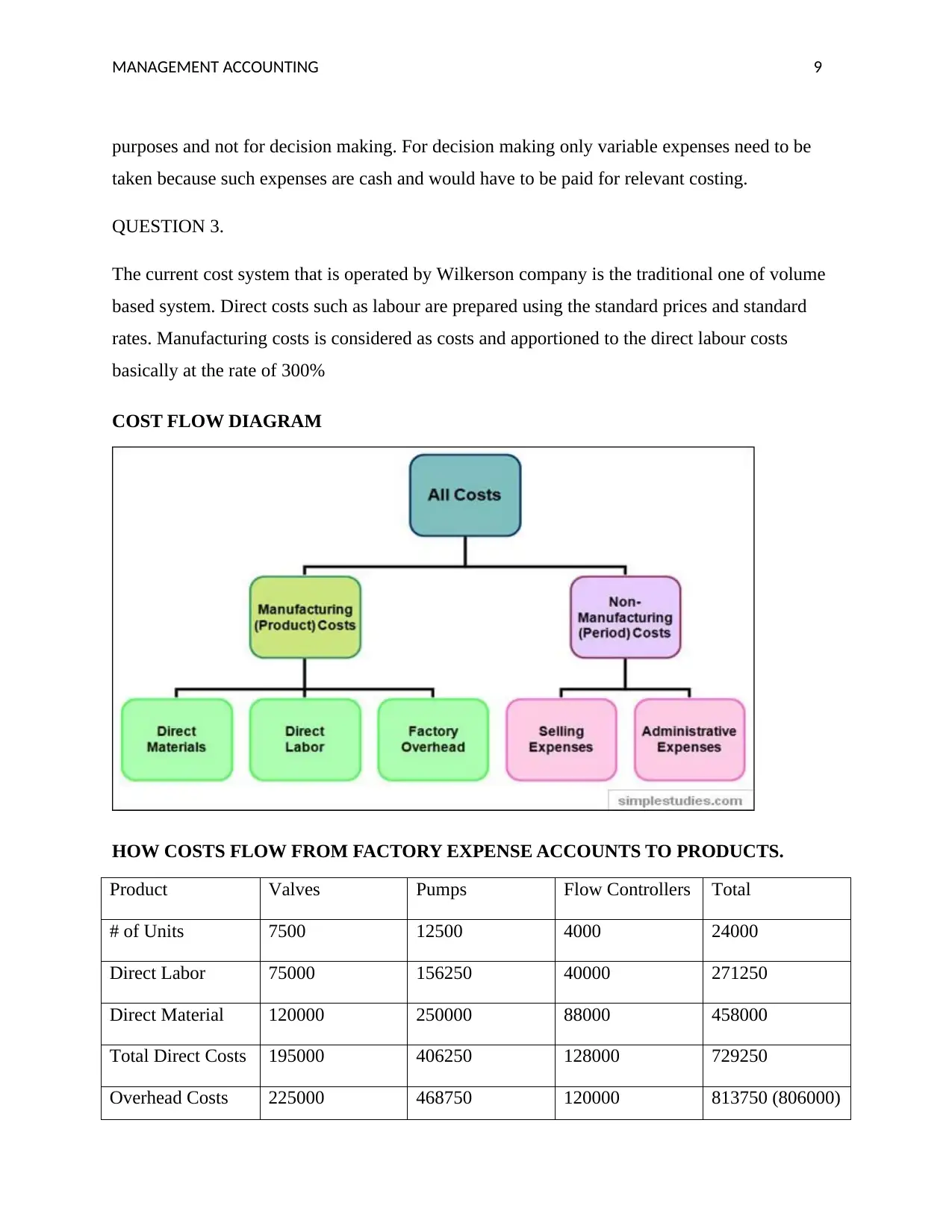
MANAGEMENT ACCOUNTING 9
purposes and not for decision making. For decision making only variable expenses need to be
taken because such expenses are cash and would have to be paid for relevant costing.
QUESTION 3.
The current cost system that is operated by Wilkerson company is the traditional one of volume
based system. Direct costs such as labour are prepared using the standard prices and standard
rates. Manufacturing costs is considered as costs and apportioned to the direct labour costs
basically at the rate of 300%
COST FLOW DIAGRAM
HOW COSTS FLOW FROM FACTORY EXPENSE ACCOUNTS TO PRODUCTS.
Product Valves Pumps Flow Controllers Total
# of Units 7500 12500 4000 24000
Direct Labor 75000 156250 40000 271250
Direct Material 120000 250000 88000 458000
Total Direct Costs 195000 406250 128000 729250
Overhead Costs 225000 468750 120000 813750 (806000)
purposes and not for decision making. For decision making only variable expenses need to be
taken because such expenses are cash and would have to be paid for relevant costing.
QUESTION 3.
The current cost system that is operated by Wilkerson company is the traditional one of volume
based system. Direct costs such as labour are prepared using the standard prices and standard
rates. Manufacturing costs is considered as costs and apportioned to the direct labour costs
basically at the rate of 300%
COST FLOW DIAGRAM
HOW COSTS FLOW FROM FACTORY EXPENSE ACCOUNTS TO PRODUCTS.
Product Valves Pumps Flow Controllers Total
# of Units 7500 12500 4000 24000
Direct Labor 75000 156250 40000 271250
Direct Material 120000 250000 88000 458000
Total Direct Costs 195000 406250 128000 729250
Overhead Costs 225000 468750 120000 813750 (806000)
⊘ This is a preview!⊘
Do you want full access?
Subscribe today to unlock all pages.

Trusted by 1+ million students worldwide
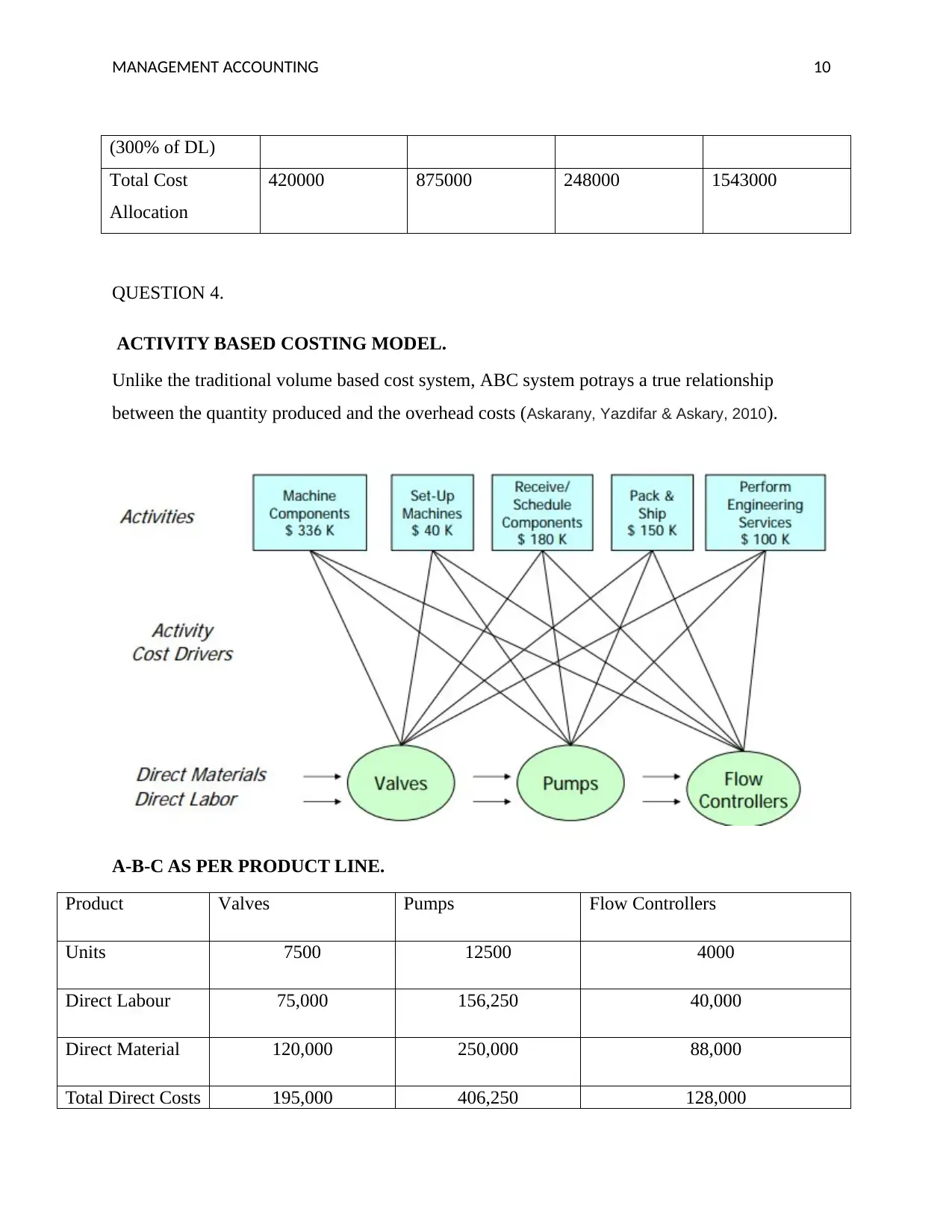
MANAGEMENT ACCOUNTING 10
(300% of DL)
Total Cost
Allocation
420000 875000 248000 1543000
QUESTION 4.
ACTIVITY BASED COSTING MODEL.
Unlike the traditional volume based cost system, ABC system potrays a true relationship
between the quantity produced and the overhead costs (Askarany, Yazdifar & Askary, 2010).
A-B-C AS PER PRODUCT LINE.
Product Valves Pumps Flow Controllers
Units 7500 12500 4000
Direct Labour 75,000 156,250 40,000
Direct Material 120,000 250,000 88,000
Total Direct Costs 195,000 406,250 128,000
(300% of DL)
Total Cost
Allocation
420000 875000 248000 1543000
QUESTION 4.
ACTIVITY BASED COSTING MODEL.
Unlike the traditional volume based cost system, ABC system potrays a true relationship
between the quantity produced and the overhead costs (Askarany, Yazdifar & Askary, 2010).
A-B-C AS PER PRODUCT LINE.
Product Valves Pumps Flow Controllers
Units 7500 12500 4000
Direct Labour 75,000 156,250 40,000
Direct Material 120,000 250,000 88,000
Total Direct Costs 195,000 406,250 128,000
Paraphrase This Document
Need a fresh take? Get an instant paraphrase of this document with our AI Paraphraser
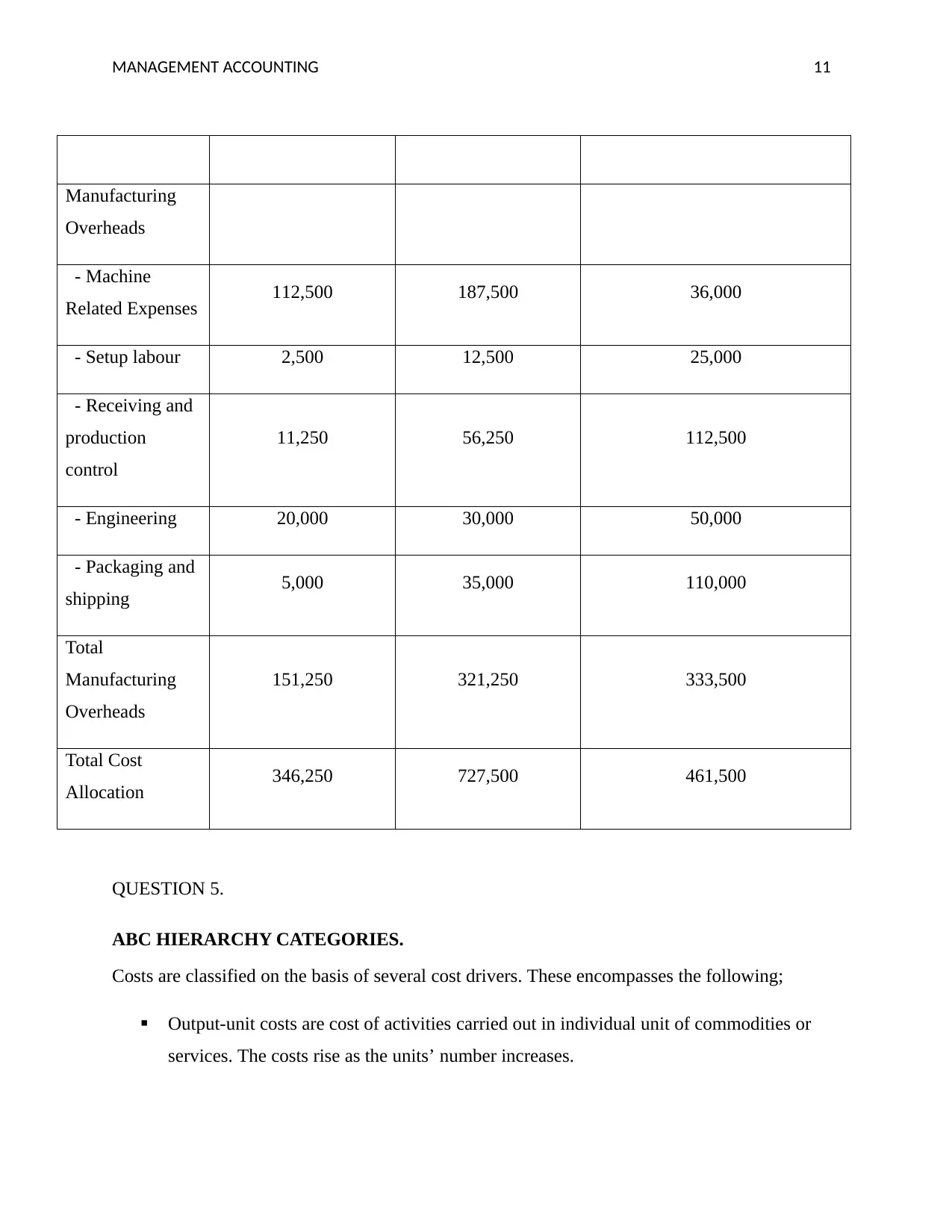
MANAGEMENT ACCOUNTING 11
Manufacturing
Overheads
- Machine
Related Expenses 112,500 187,500 36,000
- Setup labour 2,500 12,500 25,000
- Receiving and
production
control
11,250 56,250 112,500
- Engineering 20,000 30,000 50,000
- Packaging and
shipping 5,000 35,000 110,000
Total
Manufacturing
Overheads
151,250 321,250 333,500
Total Cost
Allocation 346,250 727,500 461,500
QUESTION 5.
ABC HIERARCHY CATEGORIES.
Costs are classified on the basis of several cost drivers. These encompasses the following;
Output-unit costs are cost of activities carried out in individual unit of commodities or
services. The costs rise as the units’ number increases.
Manufacturing
Overheads
- Machine
Related Expenses 112,500 187,500 36,000
- Setup labour 2,500 12,500 25,000
- Receiving and
production
control
11,250 56,250 112,500
- Engineering 20,000 30,000 50,000
- Packaging and
shipping 5,000 35,000 110,000
Total
Manufacturing
Overheads
151,250 321,250 333,500
Total Cost
Allocation 346,250 727,500 461,500
QUESTION 5.
ABC HIERARCHY CATEGORIES.
Costs are classified on the basis of several cost drivers. These encompasses the following;
Output-unit costs are cost of activities carried out in individual unit of commodities or
services. The costs rise as the units’ number increases.
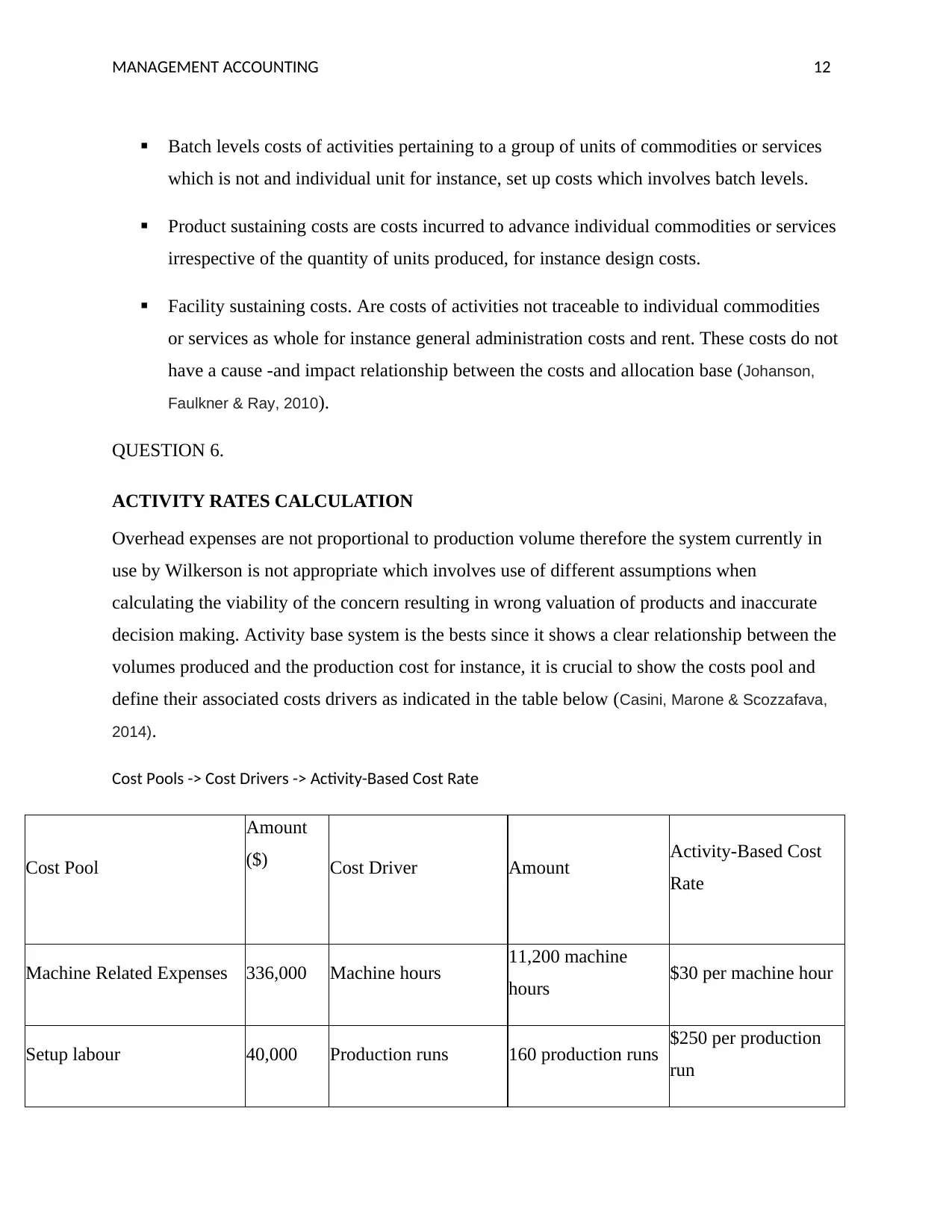
MANAGEMENT ACCOUNTING 12
Batch levels costs of activities pertaining to a group of units of commodities or services
which is not and individual unit for instance, set up costs which involves batch levels.
Product sustaining costs are costs incurred to advance individual commodities or services
irrespective of the quantity of units produced, for instance design costs.
Facility sustaining costs. Are costs of activities not traceable to individual commodities
or services as whole for instance general administration costs and rent. These costs do not
have a cause -and impact relationship between the costs and allocation base (Johanson,
Faulkner & Ray, 2010).
QUESTION 6.
ACTIVITY RATES CALCULATION
Overhead expenses are not proportional to production volume therefore the system currently in
use by Wilkerson is not appropriate which involves use of different assumptions when
calculating the viability of the concern resulting in wrong valuation of products and inaccurate
decision making. Activity base system is the bests since it shows a clear relationship between the
volumes produced and the production cost for instance, it is crucial to show the costs pool and
define their associated costs drivers as indicated in the table below (Casini, Marone & Scozzafava,
2014).
Cost Pools -> Cost Drivers -> Activity-Based Cost Rate
Cost Pool
Amount
($) Cost Driver Amount Activity-Based Cost
Rate
Machine Related Expenses 336,000 Machine hours 11,200 machine
hours $30 per machine hour
Setup labour 40,000 Production runs 160 production runs $250 per production
run
Batch levels costs of activities pertaining to a group of units of commodities or services
which is not and individual unit for instance, set up costs which involves batch levels.
Product sustaining costs are costs incurred to advance individual commodities or services
irrespective of the quantity of units produced, for instance design costs.
Facility sustaining costs. Are costs of activities not traceable to individual commodities
or services as whole for instance general administration costs and rent. These costs do not
have a cause -and impact relationship between the costs and allocation base (Johanson,
Faulkner & Ray, 2010).
QUESTION 6.
ACTIVITY RATES CALCULATION
Overhead expenses are not proportional to production volume therefore the system currently in
use by Wilkerson is not appropriate which involves use of different assumptions when
calculating the viability of the concern resulting in wrong valuation of products and inaccurate
decision making. Activity base system is the bests since it shows a clear relationship between the
volumes produced and the production cost for instance, it is crucial to show the costs pool and
define their associated costs drivers as indicated in the table below (Casini, Marone & Scozzafava,
2014).
Cost Pools -> Cost Drivers -> Activity-Based Cost Rate
Cost Pool
Amount
($) Cost Driver Amount Activity-Based Cost
Rate
Machine Related Expenses 336,000 Machine hours 11,200 machine
hours $30 per machine hour
Setup labour 40,000 Production runs 160 production runs $250 per production
run
⊘ This is a preview!⊘
Do you want full access?
Subscribe today to unlock all pages.

Trusted by 1+ million students worldwide
1 out of 20
Related Documents
Your All-in-One AI-Powered Toolkit for Academic Success.
+13062052269
info@desklib.com
Available 24*7 on WhatsApp / Email
![[object Object]](/_next/static/media/star-bottom.7253800d.svg)
Unlock your academic potential
Copyright © 2020–2025 A2Z Services. All Rights Reserved. Developed and managed by ZUCOL.





